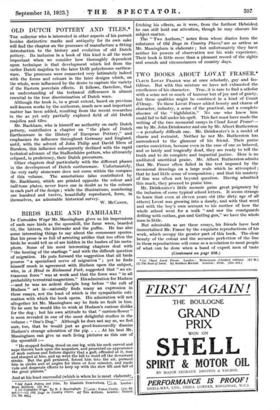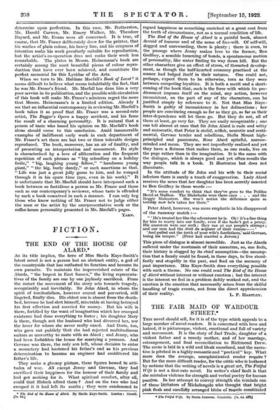TWO BOOKS ABOUT LOVAT FRASER.*
CLAUD Lovwx FRASER was at once scholarly, gay and fas- tidious. But with this mixture we have not exhausted the excellences of his character. True, it is rare to find a scholar with a sense not so much of humour but of joy and of gaiety, but these qualities might be combined in a kind of Count d'Orsay. To these Lovat Fraser added beauty and charm of character, industry, a sense of the practical, and a complete absence of the "highfalutin." No one who knew him could fail to fall under his spell. This fact must have made the writing of the two memorial essays in Claud Lovat Frame— one by Mr. John Drinkwater and one by Mr. Albert Rutherston —a peculiarly difficult one. Mr. Drinkwater's is a model of charm and restraint. Neither he nor Mr. Rutherston has surrendered to the glamour of his friend. Their praise carries conviction, because even in the case of one so beloved, and so lately and tragically dead, they are ready to tell the truth and to do complete and impartial justice. Here is no undiluted uncritical praise. Mr. Albert Rutherston admits that Mr. Fraser often failed in the test imposed by the occasional drawings on a large scale which he attempted ; that he had little sense of composition ; and that his mastery of line was often not beyond question. Having admitted this much, they proceed to praise him.
Mr. Drinkwater's little memoir gains great poignancy by the inclusion of some typical school letters. It seems strange to learn that even at eleven years old (the dirty age of all others) Lovat was growing into a dandy, and with that word and with the boy's own account to his mother of how the whole school went for a walk "and saw the coastguards drilling with cutlass, gun and Gatling gun," we have the whole man in little.
But admirable as are these essays, his friends have best immortalized Mr. Fraser by the exquisite reproductions of his work, which occupy the greater part of this book. The clear beauty of the colour and the accurate perfection of the line in these reproductions will come as a revelation to most people of what can be done when a band of expert men of taste (Continued on page 858.) • (1) Claud Loyal Fraser. London : Heinemann (Limited edition). (55 Os.] (2) The Book of Lovat. by Haldane Madan. London : Dent. 1251. net.) determine upon perfection. In this case, Mr. Rutherston, Mr. Harold Clown, Mr. Emery Walker, Mr. Theodore Bayard, and Mr. Evans were all concerned. It is true, of course, that Mr. Fraser deliberately drew for the printer, that his washes of plain colour, his heavy line, and his crispness of intention make his work peculiarly suitable for reprodaetion, but the artist's co-operation does not make their work less remarkable. The plates in Messrs. Heinemann's book are certainly among the most beautiful pieces of colour repro- duction that have ever been achieved, and constitute the perfect memorial for this Lycidas of the Arts.
When we turn to Mr. Haldane Macfall's Book of Lovat 2 it seems difficult to believe what seems indubitably the fact, that he was Mr. Fraser's friend. Mr. Madan has done him a very poor service in its publication, and the possible wide circulation of this book will make Mr. Fraser's admirers regret the more that Messrs. Heinemann's is a limited edition. Already I see that an influential contemporary in reviewing Mr. Macfall's book takes it as proof that Mr. Fraser was a second-rate artist, The Beggar's Opera a happy accident, and his fame the result of a charming personality. It is natural that a person of taste who based his opinion on Mr. Macfall's book alone should come to this conclusion. Amid innumerable examples of indifferent early work- in each department of Mr. Fraser's art there are but two or three tolerable designs reproduced. The book, moreover, has an air of finality, and of presenting an interpretation and assessment. Its style is characterized by a love of alliteration and the frequent repetition of such phrases as 'big schoolboy on a holiday frolic," "big, laughing young fellow," "handsome young giant," "the big, burly dandy," or such assertions as that. "Life was just a great jolly game to him, and he romped through it in his spare time (aye, even in his work)." It is unfortunate that Mr. Madan should. have interposed such a book between so fastidious a person as Mr. Fraser and those such as our Contemporary's reviewer, whose taste is offended by such a book conceived in such a manner. I can only beg those who know nothing of Mr. Fraser not to ju ge either the man or the artist by the unrepresentative work or the coffee-house personality presented in Mr. Macfall's pages.
TARN.



































 Previous page
Previous page